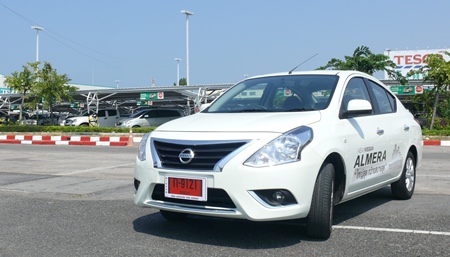A few weeks ago I tested the new Nissan Teana, and was very impressed with the vehicle. This week, Khun Ju of Pattaya Automobile Co. (on Sukhumvit Road, about 50 meters past the Ambassador City and on the same side) offered the Nissan Almera, seeking my opinion on the Teana’s smaller brother.
Mind you, Nissan has an unrivalled propensity for finding nonsensical names. Remember the Nissan Cedric of 40 years ago? Or the recent Nissan Tiida? Or even the current Juke and Sylphy? Just where do they get these names? A quick search turned up the fact that “Almera” is of Arabic origins and means Princess. Hardly an attractive name, but is it an attractive car?
 Nissan Almera
Nissan Almera
This Nissan Almera is derived from the Nissan March eco-car, which was released a couple of years back. The Almera is also considered an eco-car, and is thus restricted to the 1.2 litre engine from the March. (In Malaysia the Almera has a 1.5 litre engine, not being restricted by the Thai specifications.)
Direct competitors in the B segment to the Almera in the marketplace include the Toyota Vios and the Honda City.
The first impression one gets of the Almera is one of size. It is not a small car and is generally larger than its rivals in the B segment.
Almera: 4425 mm (L) x 1695 mm (W) x 1500 mm (H), wheelbase: 2600 mm
VIOS: 4410 mm (L) x 1700 mm (W) x 1475 mm (H), wheelbase: 2550 mm
City: 4415 mm (L) x 1695 mm (W) x 1480 mm (H), wheelbase: 2600 mm
The exterior styling is a matter of personal taste. The front is quite pleasant with its Lexus-like grille, but I cannot connect with the “ironed” slab sided rear panels. Doors are of good size and entrance and exit are easy. The steering wheel is also adjustable in height, and it was possible to get a good driving position. The seats were also comfortable.
Not only does it look full-size from outside the car, once settled in, the interior is very large and the five seats are not at all squeezy. From the inside, it does not feel like a small car in any way. Even with the driver’s seat racked way back, there was ample room for the rear seat passenger’s legs.
One of the first items to learn to accept is the Idle-Stop system. This ingenious electro-trickery turns the engine off when sitting stopped at traffic lights, resulting in improved fuel consumption figures. But then lift your foot from the brake pedal and the engine re-starts and away you go. Initially when stopped and finding a large bus each side of me and another hovering over the rear bumper bar made me pray that it would restart, but after the first few times I began to accept that it would work, and prayer was not necessary.
With only a 1.2 litre 79 BHP engine the Almera is no drag-racer, but the engine is not at all fussy and is adequate both in city driving and open road, returning around 20 km per litre of gasoline. With a 40 litre tank this works out as a distance of 800 km per tank.
The CVT transmission is exceptionally smooth and never seems to get confused as some automatic transmissions can do, and the gear changes are seamless.
The steering is light at parking speeds but gets progressively firmer as the speed increases. It is very easy for a woman to park the Almera.
It is very quiet in operation, and comfortable, has a cavernous boot and ideal for the weekly supermarket expedition.
There are six models, with the base S (manual) at B. 433,000.
E (manual) B. 464,000
E (CVT) B. 498,000
EL (CVT) B. 532,000
V (CVT) B. 572,000
VL (CVT) B. 608,000
Dislikes: Not too many, particularly when you look at the price. Even the top of the line model as tested is only B. 608,000 and has ABS, EBD and BA. However, I would like a central console with arm rest, and the top models should have daytime running lights. There are only two airbags, and considering the amount of electronics already in the Almera, side curtain airbags should not be too difficult to incorporate at the design stage.
Features I did like included the very simple to operate air-conditioning as opposed to drop-down menus. The GPS was clear, though it was a trifle annoying having to “agree” to the terms of reference every time before setting off. However, it is one of those developments it is hard to imagine being without.
Looking at the B segment, the Almera is by far the cheapest and is certainly worth your investigating. It does have the smallest engine and is exceptionally economical. On the other side of the coin, it is the least powerful amongst its rivals, but to be honest, do you need Formula 1 acceleration in Pattaya’s congested streets. As long as you can outrun the busses, what more is needed, and especially looking at the purchase cost which ranges from B. 433,000 base model to 608,000 top of the line.
The best advertisement is always word of mouth and I found one owner in my office. His was a top of the line Almera and he had owned it for 12 months, and was effusive with praise. He found, as I did, that it was a very pleasant and comfortable motor car. His only recommendation was to lower the tyre pressures by a few psi to enhance the comfort, and again I would agree, but only by around 2-3 psi for safety reasons.
Test car supplied by Pattaya Automobile Co., a new Nissan dealership with all the infrastructure required for sales and service.
Address: 222 Moo 2, Sukhumvit Road, Tambol Najomthien, phone 038 255-800.




